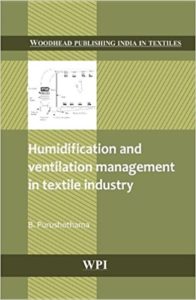Humidification and Ventilation Management in Textile Industry
Humidification and Ventilation Management in Textile Industry
Humidification and Ventilation Management in Textile Industry was written as The importance of maintaining and managing humidity and temperature in a textile mill is not a new concept, but understanding the requirements, the equipment capabilities and utilizing them to get the best re sults is a challenge the technicians face all the time. Now the systems have changed from manually operated to fully automatic; however, unless one knows how to monitor, he shall still have the problem. Some guidelines are needed for the shop floor technicians relating to maintenance o f humidity and monitoring the air.
Production and quality can be significantly impacted if improper selection or inadequate maintenance of temperature and humidity measures. Based on the authors 38 years in the textile industry, this book explains the principles adopted in different humidification plants and their adoption. The author translates his experience working as technician dealing with the problems of humidification it into a comprehensive, authoritative guide.
You can also read Natural Ventilation in Non-domestic Buildings
Humidification and Ventilation Management in Textile Industry Product details
- Series: Woodhead Publishing India
![Humidification and Ventilation Management in Textile Industry]()
- Hardcover: 415 pages
- Publisher: CRC Press; 1 edition (February 10, 2010)
- Language: English
- ISBN-10: 8190800124
- ISBN-13: 978-8190800129
- Product Dimensions: 6 x 1.2 x 9 inches
- Shipping Weight: 1.8 pounds
Apart from the dust levels, the stickiness in some of the cottons also demands controlled weather. When cotton is sticky, higher humidity creates sticking of fibres to rollers and other parts of the machine. The general reasons for controlling temperature and humidity in a textile mill are as follows:
• Dry air causes lower regain and this contributes to poor quality also lower productivity.
• Yarns with low moisture content are weaker, thinner, more brittle and less elastic, also create more friction and are more prone to static electrification.
• Materials at optimum regain are less prone to breakage, heating and friction effects; they handle better, have fewer imperfections, are more uniform and feel better.
• Higher humidity reduces static problems. Reduced static makes materials more manageable and also increases machine speed.
• Low humidity causes fabric shrinkage. Maintained humidity permits greater reliability in cutting and fitting during garment creation and contributes to the maintenance of specification where dimensions are important, such as in the carpet industry.
• Humidification reduces fly and micro-dust, giving a healthier also more comfortable working environment.


Comments are closed.